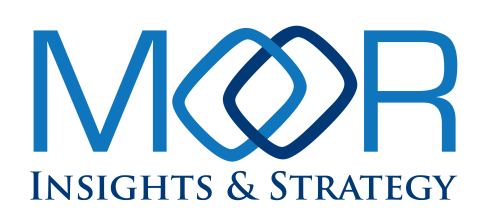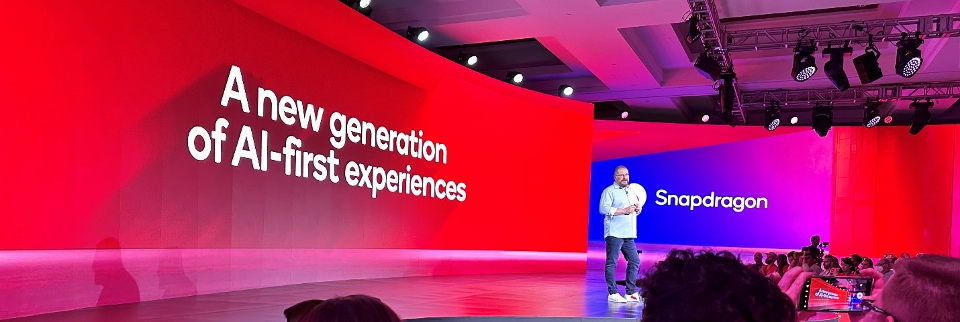
Welcome to this edition of our Weekly Analyst Insights roundup, which features the key insights our analysts have developed based on the past week’s events.
Each autumn, Qualcomm hosts its Snapdragon Summit on the island of Maui to showcase its newest technologies. As longtime Moor Insights & Strategy analyst Will Townsend noted in his writeup of Qualcomm’s new mobile networking chips, “It’s an awe-inspiring setting for a technology conference.” And yet the gorgeous tropical environment makes for a wonderful backdrop rather than a distraction because Qualcomm and the attendees are all so engaged with the business at hand.

This time of year, the seemingly endless sequence of tech conferences can feel like a grind at times. How could it not, with so many different flights, hotels, and restaurant meals? But I wouldn’t trade it, because that’s where the action is for the newest technology just coming to market. And because sometimes it’s precisely when you’re in some distant metropolis (or Hawaiian island) that you can look at technology—new and old—with fresh eyes.
This week, Matt, Anshel, Paul and I will attend the Dell Tech Analyst Summit in Austin, while Jason will attend the Apptio TBM Conference in San Diego.
Last week, I was at AWS HQ in Seattle for an exclusive re:Invent preview, then spent some time in Los Angeles for the analyst session at Cisco’s Partner Summit. (Don’t miss the Six Five On the Road interviews with Cisco executives from the event.) Mel tuned into SAP SuccessConnect Virtual to dig into everything happening in HCM. Jason (virtually) and Matt attended the Red Hat Analyst Day in Boston while Will was in Riga at 5G Techritory. Will moderated two panels at the event on topics ranging from road connectivity to bridging the gap between industry, research, and public understanding of 5G innovation. Robert hosted a webinar with Sam Gupta, principal consultant at ElevatIQ, to discuss 2025 ERP trends and how businesses can prepare for digital transformation.
Read more about these events in the respective analysts’ insights.
Have a great week!
Patrick Moorhead
———-
Our MI&S team published 14 deliverables:
Over the last week, MI&S analysts have been quoted in multiple top-tier international publications with their thoughts on Amazon, AMD, AT&T, Celona, Google, Intel, SAP, agentic AI, earnings, wearables, and more. Patrick appeared on CNBC Asia and Yahoo! Finance to discuss Intel Q3 2024 earnings.
MI&S Quick Insights
Last week AWS announced inline editing for Amazon Q Developer, among a series of other new capabilities. Inline editing is very much in line (ha!) with AWS’s commitment to an efficient pro developer experience. Instead of the AI working in a window next to the coding workspace, you can now inject AI recommendations right into your work. What’s nice is that it needs to be invoked via a command key instead of just looming there all the time. Initial findings suggest that developers like using inline editing when they are truly stuck on something where they may lack familiarity. Think of something like a whole routine versus just something at the line level. The intended benefit is that devs will get richer and more verbose assistance, leading to even greater productivity. It will be very interesting to see how this approach moves the needle in metrics such as accepted changes, which is something that AWS is tracking and publishing regularly.
GitHub hosted its Universe event last week and made two major announcements. The first is that GitHub Copilot will now support the use of multiple LLMs. While this is not a new concept, given that many other developer tools do this, it’s interesting since Gitub has been all-in on using parent company Microsoft’s Copilot LLM until now. Additionally, GitHub announced a new no-code tooling and runtime offering called Spark, which is geared towards citizen and business developers. My initial thought is that this tool is geared towards business users who want to build simple forms-based applications, as opposed to power users who want to incorporate workflows and processes. Again, this is a capability that many other companies already have. And to be honest, it’s interesting to see GitHub branching out to attract new users. Especially since a shared set of repositories and services could be of value to enterprises. What will be more interesting is to see how this introduction shapes Microsoft’s low-code and no-code strategy, which currently spans multiple projects.
Red Hat hosted an analyst event in which its leadership walked through its AI strategy and other product updates. However, just like at IBM’s Analyst Summit a couple weeks ago, Red Hat could not resist talking about its major push to move customers from VMware to its OpenShift Virtualization offering. To be candid, it’s not cool, sexy, or even new since Red Hat has been in the virtualization game for decades now. But, frankly, it’s a sneaky-brilliant monetization play. Red Hat has a very strong history in executing pricing disruptions in commoditized and semi-commoditized markets (Unix to RHEL, BEA to JBoss). And Red Hat typically needs a lot of time to spin up in new markets (like AI). This is very typical of low-cost players in any marketplace. So while Red Hat talks the AI talk, my sense is that continued financial results will come from ripping-and-replacing hypervisors for a while. Red Hat will then attempt to parlay that customer savings into consideration for more modern solutions From Red Hat or parent IBM down the road.
Last week AWS announced inline editing for Amazon Q Developer, among a series of other new capabilities. Inline editing is very much in line (ha!) with AWS’s commitment to an efficient pro developer experience. Instead of the AI working in a window next to the coding workspace, you can now inject AI recommendations right into your work. What’s nice is that it needs to be invoked via a command key instead of just looming there all the time. Initial findings suggest that developers like using inline editing when they are truly stuck on something where they may lack familiarity. Think of something like a whole routine versus just something at the line level. The intended benefit is that devs will get richer and more verbose assistance, leading to even greater productivity. It will be very interesting to see how this approach moves the needle in metrics such as accepted changes, which is something that AWS is tracking and publishing regularly.
GitHub hosted its Universe event last week and made two major announcements. The first is that GitHub Copilot will now support the use of multiple LLMs. While this is not a new concept, given that many other developer tools do this, it’s interesting since Gitub has been all-in on using parent company Microsoft’s Copilot LLM until now. Additionally, GitHub announced a new no-code tooling and runtime offering called Spark, which is geared towards citizen and business developers. My initial thought is that this tool is geared towards business users who want to build simple forms-based applications, as opposed to power users who want to incorporate workflows and processes. Again, this is a capability that many other companies already have. And to be honest, it’s interesting to see GitHub branching out to attract new users. Especially since a shared set of repositories and services could be of value to enterprises. What will be more interesting is to see how this introduction shapes Microsoft’s low-code and no-code strategy, which currently spans multiple projects.
Red Hat hosted an analyst event in which its leadership walked through its AI strategy and other product updates. However, just like at IBM’s Analyst Summit a couple weeks ago, Red Hat could not resist talking about its major push to move customers from VMware to its OpenShift Virtualization offering. To be candid, it’s not cool, sexy, or even new since Red Hat has been in the virtualization game for decades now. But, frankly, it’s a sneaky-brilliant monetization play. Red Hat has a very strong history in executing pricing disruptions in commoditized and semi-commoditized markets (Unix to RHEL, BEA to JBoss). And Red Hat typically needs a lot of time to spin up in new markets (like AI). This is very typical of low-cost players in any marketplace. So while Red Hat talks the AI talk, my sense is that continued financial results will come from ripping-and-replacing hypervisors for a while. Red Hat will then attempt to parlay that customer savings into consideration for more modern solutions From Red Hat or parent IBM down the road.
Osmo.ai is able to capture and digitally recreate a scent. That means a scent can be teleported from one location to another. The company uses gas chromatography-mass spectrometry (GCMS) to analyze a given scent so it can be uploaded to Osmo’s cloud-based Primary Odor Map, which uses AI to predict the molecular composition. Next, a formulation robot creates the scent by mixing different molecules. Osmo produces high-fidelity scent replication, and it can capture even the subtlest nuances of a scent. The system is almost fully automated, and human assistance is needed only at the input and output stages. As a result of its experimentation, Osmo has accumulated the largest AI-compatible scent databank, which is now used for training the AI.
Osmo has the opportunity to create a number of new use cases. Perfume retailers could digitally transmit a perfume’s scent to potential customers. Because scent has an important role in memory and emotion, Osmo believes the technology could be used for PTSD or dementia therapy by recreating comforting or significant scents. All in all, the technology could blend the physical and digital worlds and offer a new way to experience and share sensory information.
I’ve been thinking through the recent announcement regarding the partnership between NTT Data and Oracle Cloud Infrastructure. In essence, NTT will be using (or OEM-ing) the Oracle Alloy cloud infrastructure platform to deliver sovereign cloud services to its customers—initially in Japan, with plans to expand over time.
Can we stop and take a moment to look at the novel ways Oracle is building OCI’s relevance? Through Alloy, Database@[CSP], HeatWave, Cloud@[customer], and a number of other avenues, OCI is becoming an indispensable part of the cloud marketplace. Rather than solely focusing on delivering better services at a lower price point than the competition (which it also does), Oracle is looking at embracing traditional competitors to better meet the needs of enterprise customers.
What a unique and smart approach.
I attended Red Hat’s analyst summit in Boston last week, and there were two themes front and center: AI and VMware. While focusing on these may sound somewhat boring to analysts, this is a smart move as these are the top two infrastructure focus areas for any IT organization of size across the industry.
On the VMware front, Red Hat has a solid competitive story with OpenShift. In fact, right now the post-VMware reality for many IT organizations comes down to a two-horse race—Nutanix or Red Hat. I think Red Hat’s depth in cloud-native/containerization combined with its virtualization makes for a compelling story. Further, its long reach into the enterprise datacenter perhaps gives it a little bit of an advantage in pursuing the larger opportunities. With that said, I don’t believe that Red Hat has been aggressive enough in establishing and amplifying its dominant position. My expectation is that we will see the volume turned up in 2025.
Looking at AI, Red Hat seems to be in a little bit of a muddled place in the market as it tries to focus on RHEL AI and OpenShift as foundational elements of the enterprise AI equation. While I can see the story after spending a day with the company, I believe this is another marketing opportunity for Red Hat to educate and engage with enterprise IT. It is critical to be a part of the early AI discussion and project planning if Red Hat hopes to be successful.
It was earnings week for AMD and Intel. Both companies demonstrated growth and progress. However, the markets certainly treated each of them differently.
In the case of AMD, the company showed strong datacenter performance for its fiscal third quarter with revenue of $3.5 billion, representing a 122% year-over-year increase, and operating income of $1.04 billion, a whopping 240% YoY increase. Overall, AMD beat expectations for revenue and met them for EPS. Interestingly, the market was down on AMD (about 15% since earnings) due to the company’s conservative guidance and its weakness in other contributions to revenue (e.g., gaming). Realistically, I don’t believe that investors are viewing AMD negatively; rather, they are normalizing after a hype period that followed the company’s very aggressive take on the AI market.
As an ex-AMD employee, I don’t think there is a single person in Austin or Santa Clara (or Markham) who is disappointed with a $141 share price—save Dr. Lisa Su and the CFO. However, I do believe we will continue to see a little less stability in the stock price as the AI chip market continues to evolve, even though I believe that AMD is making all the right long-term bets for the AI future.
Intel also showed growth in its datacenter segment on revenues of $3.3 billion, representing YoY and sequential growth. Its $300 million in operating income represents margins of 10.4%—also up sequentially. Following the company’s earnings, the market showed favorable coverage as the stock moved up about 2%. Further, a number of institutional investors have raised their target buy price for Intel’s stock.
Intel’s financials were a lot more nuanced than what we saw from AMD. The company is going through a major restructuring, with many of the restructuring costs impacting bottom-line numbers. It seems investors are accounting for this and showing confidence in the work that CEO Pat Gelsinger and team are doing to right the ship.
Stock prices are about expectations: meeting, beating, or failing to meet. Intel has done a good job of managing the investor community as it continues its multi-year turnaround.
Cisco recently held its partner summit, using it to announce a revamped compensation and training initiative. What I really like about the Cisco 360 Partner Program is the long-lead-time deployment, which should ensure a smooth introduction in 2026. The company is also making a substantial $80 million investment in training to facilitate meaningful opportunities for the company’s channel sellers to expand their capabilities for providing expertise across AI, networking, security, observability, and more.
As regulatory demands for environmental accountability grow, enterprises need to track and manage carbon footprints across supply chains. SAP’s new Sustainability Data Exchange (SDX) offers a platform for standardized data sharing and improved emissions accounting. Ahead of the COP29 meeting in November 2024, SDX provides enterprises with tools to support international climate goals, particularly in sharing Scope 3 emissions data across the value chain. Integrated with SAP S/4HANA Cloud ERP, SDX enables precise data exchange of carbon emissions among businesses and their suppliers and customers. It helps address the issues created by outdated tools, data inaccuracies, and inconsistent calculations, helping enterprises move from estimations to actual emissions data provided by suppliers. Read more in my latest Forbes article on SAP’s Sustainability Data Exchange.
AI agents are becoming integral to ERP systems, creating a balance between automation and human oversight. Leading ERP providers are embedding these agents as a core component of their recent innovations. AI agents offer real benefits by supporting task management and improving operational efficiency in areas such as forecasting, customer satisfaction in sales and marketing, and collaboration across the supply chain. By managing routine tasks, these agents simplify ERP interactions, making the systems easier for users to navigate and apply across various business functions. As I’ve suggested in the past, strong data management strategies are necessary for these benefits to be attainable—AI agents rely on accurate, up-to-date data to be effective.
Blue Yonder’s Q3 2024 results show that the company added 31 new customers, including BJ’s Wholesale Club, PepsiCo’s Latin American unit, and Sainsbury’s. Its recent acquisition of One Network Enterprises expands Blue Yonder’s capabilities with real-time collaboration and data sharing across supply chains. Blue Yonder’s latest features include the Intelligent Rebalancer for real-time order adjustments, the Fulfillment Sourcing Simulator for optimizing fulfillment, and tools for automating warehouse and yard tasks. Updates to Cognitive Demand Planning improve forecasting and planning, providing clients with more accurate, flexible supply chain management solutions.
Blue Yonder has identified some key SCM industry trends this quarter, including rising food costs pushing grocery retailers toward value-focused inventory strategies, increasing demand for traceability due to U.S. and EU regulations, and labor and logistics challenges leading companies to cross-train staff and relocate distribution centers closer to U.S. markets. Additionally, manufacturers are adopting generative AI tools to enhance supply chain efficiency, customer service, and cost management. I see these trends as critical real-world challenges that Blue Yonder addresses to support its clients’ complexities and to align with today’s operational and regulatory demands.
As announced last week at the Money 20/20 conference, NVIDIA has introduced an AI-powered workflow for fraud detection running on AWS. With financial losses from credit card fraud projected to reach $43 billion by 2026, this solution is critical. The workflow leverages advanced algorithms and accelerated data processing to identify fraudulent transactions more accurately than traditional methods, potentially improving detection by up to 40%. It takes advantage of NVIDIA’s AI Enterprise software platform, GPUs, and tools including RAPIDS AI libraries and the Morpheus application framework to enhance fraud detection models and streamline their deployment.
For context, financial institutions are increasingly adopting AI and accelerated computing to combat fraud. This new workflow aims to provide a comprehensive solution for fraud use cases beyond credit card transactions, including new account fraud, account takeover, and money laundering. While fraudsters can also exploit AI to develop new and sophisticated schemes, AI equips the good guys with powerful tools to analyze vast amounts of data, detect subtle patterns, and adapt to evolving threats to fight back.
Across three days last week I attended multiple SAP SuccessConnect virtual sessions, during which several key trends in human capital management surfaced. I noted a strong emphasis on strategic workforce planning, particularly the need for proactive approaches to address skills gaps, enhance employee competencies, and support career transitions. Speakers frequently highlighted the importance of integrating HR and financial data to drive growth. Many sessions showcased and acknowledged the potential of AI in HCM, but also emphasized the importance of responsible AI development and deployment to prevent bias. I observed a recurring theme around the critical role of data analytics in understanding workforce trends and informing effective HCM strategies. SAP’s acquisition of WalkMe appears to generate positive results within SuccessFactors, with reports of improved user experience, increased task completion rates, and higher overall satisfaction.
Amal Clooney’s keynote address was a highlight of the event for me. She offered a compelling look at real-world use cases of AI in human rights and the workforce, providing valuable insights into the broader societal impact of these technologies.
I often write about the increasing practicality of using AI and machine learning techniques in small, low-power edge devices. NXP’s new AI-enhanced chips and high-productivity edge AI software development tools align with this trend.
NXP i.MX RT700 — NXP is doubling down on intelligence for small devices with AI-enhanced SoCs, new AI development tools, and eIQ Neutron, an internally developed family of NPUs (neural processors). The company recently introduced the i.MX RT700 “crossover” SoC, designed for ultra-low-power smart devices. (In NXP parlance, crossover MCUs are simple, low-power processors with MPU-like performance.) I don’t usually dive into the technical details of SoC designs in these weekly summaries, but this chip is noteworthy because of its heterogeneous design. There are two Cortex-M33 compute subsystems, each with a DSP (Tensilica HiFi). One M33 is the main processor for the chip, and the other is a low-power subsystem for always-on applications such as keyword recognition. The chip also has a modest graphics subsystem, a dedicated I/O processor (RISC-V), and an advanced memory architecture optimized for multiprocessor partitioning. The chip’s most disruptive compute subsystem is its eIQ Neutron N3-64 NPU. NXP claims the NPU provides a 172x performance boost and 119x per-inference power decrease compared with “general purpose processors.”
NXP eIQ tools — This week, NXP announced two new software enablement tools for the eIQ NPU family: eIQ Time Series Studio (TSS) and eIQ GenAI Flow. TSS automates machine learning workflows, streamlining time-series-based machine learning model development and deployment across MCU-class devices such as the i.MX RT700. Applications include anomaly detection, classification, and regression for many types of sensor data. The development model is BYOD (bring your own data), and the TSS development flow simplifies model tuning, optimization, and deployment. GenAI Flow provides building blocks for large and small language models (LLMs, SLMs) that power applications for generation and reasoning. These large models run on NXP’s i.MX MPU processor families. GenAI Flow makes generative AI applications accessible on these devices and supports retrieval-ugmented generation (RAG), a technique for securely fine-tuning models on domain-specific knowledge and private data.
Efficient application development for complex chips such as the i.MX RT700 requires more than a board support package (BSP) on GitHub. These devices are complete computer platforms, so developers need hardware, software, and tools that “just work” with mainstream OS distributions right out of the box, including support for all the accelerators and specialized function blocks on the chip—AI, DSPs, low-power compute subsystems, I/O, graphics, security, memory management, connectivity, and networking. I’m pleased to see NXP enabling application developers to focus on applications rather than system code.
Apple has expanded its relationship with Globalstar via a $1.1 billion investment, which gives Apple a 20% stake in the company and guarantees it a new satellite constellation for satellite messaging and other satellite services. This new constellation will have 85% of its capacity dedicated to Apple, and Globalstar can allocate the remaining 15% for its own customers. This gets Apple to become its own service provider, a route that I expected it would achieve with a 5G network slice well before I would’ve expected it over satellite. That said, this new network won’t replace terrestrial connectivity, but it does guarantee iPhone users nearly global coverage and likely enhanced satellite services once that new constellation goes up.
The OnePlus 13 has been announced in China and is already showing some stellar specs and performance, including a 6,000 mAh battery, an under-screen fingerprint sensor, and a Snapdragon 8 Elite SoC. Chinese reviewers who have already gotten their hands on the OnePlus 13 are reporting it as the new king of performance on tests in the AnTuTu benchmarking tool. OnePlus did this all while making the phone thinner and adding IP69 water resistance, which is higher than the previous IP65 rating and even higher than devices that proudly proclaim IP68 water resistance. I will be attending the company’s U.S. launch later in December and will give my thoughts after I’ve seen this device for myself.
RingCentral has announced that its AI Assistant is now included at no additional cost for RingEX users. This provides access to features like live transcription, closed captioning, meeting summaries, real-time call note capture, text and chat message writing, editing, and translation across different tiers. This strategic move allows RingCentral to demonstrate the value of its AI capabilities, potentially driving wider adoption of AI-powered solutions across its product portfolio. By giving users a taste of the efficiency gains and communication enhancements possible through AI, RingCentral encourages further exploration and integration of these technologies within its ecosystem.
Google’s Q3 2024 results indicate the growing influence of AI on its modern work solutions and overall Google Cloud business. Introducing the Customer Engagement Suite and its adoption by prominent clients such as Volkswagen of America show a strategic focus on enhancing AI-driven customer experience. The company reported improvements in work quality among Google Workspace users leveraging Gemini AI—and as a user myself, I would agree with this sentiment. While Google does not provide specific revenue breakdowns for these segments, the company’s overall solid revenue growth for Google Cloud (35% year-over-year, reaching $11.4 billion) and its attribution of this growth to increased generative AI adoption indicate that AI is a significant driver of its Cloud business. This data suggests that Google’s AI-powered tools have attracted new customers, facilitated more significant deals, and increased product adoption among existing users.
Apple announced a series of new Mac computers based on the new M4, M4 Pro, and M4 Max chips. These include the Mac Minis, MacBook Pros, and iMacs. Apple’s M4 series now starts with a 10-core CPU/10-core GPU configuration and ranges up to an M4 Max with 16 CPU cores and 40 GPU cores. Apple also finally admitted defeat over its claim from last year that 8GB of memory is adequate for AI applications; it simply isn’t enough. CoPilot+ PCs and now almost all new Macs include a minimum of 16GB of memory, including the 15-inch M3 MacBook Air and 13-inch M2 MacBook Air. This is a huge win for consumers.
The new Kindle Colorsoft has officially launched and it’s everything you would’ve hoped for from a color Kindle. It still has all the great advances in the latest Kindle Paperwhite, including great water resistance and a bright screen; it just has a color screen that looks great—and it still delivers an enjoyable Kindle experience.
Microsoft has unfortunately delayed Recall once again, this time pushing the feature’s release out to December. Realistically, this means that Recall won’t reach most users until next year, given that the initial release will be via the Preview channel; Microsoft said the feature would be there for a while as the company works out bugs and other issues. This is truly disappointing, and I believe these delays are hurting the entire Copilot+ PC narrative and the rollout of AI PCs in general. Microsoft took the narrative by the horns with Copilot+ PCs, but seems to have tripped over itself repeatedly since then.
The U.S. Department of Energy’s Advanced Research Projects Agency-Energy (ARPA-E) has announced $30 million in funding for the Quantum Computing for Computational Chemistry (QC3) program. The objective is to develop quantum algorithms that are better than existing chemistry and materials science simulations from classical computing. The ultimate goal is to design new industrial catalysts, discover superconductors for efficient electricity transmission, and improve battery chemistries.
Classical computing is unable to handle the full complexity of simulating the chemistry and materials needed for energy research and development. However, quantum computing has the potential to overcome these limitations. Project teams will be assigned specific problems in chemistry or materials science where quantum computing can be applied to reduce greenhouse gas emissions. The objective is to obtain a 100x improvement over classical methods or a scalable approach to achieving this, validated on existing quantum hardware.
CrowdStrike and Fortinet recently announced a partnership that aims to integrate AI-native endpoint security protection from the CrowdStrike Falcon platform into Fortinet’s FortiGate next-generation firewall portfolio. It seems like an unconventional partnership, given that both companies compete for the same set of customers. However, the collaboration has the potential to marry best-of-breed cybersecurity protection capabilities, enhancing threat protection and delivering optimized security outcomes.
AT&T recently announced a new fiber and 5G fixed wireless access gateway. On the surface, the solution could be attractive for branch operations where downtime equates to immediate loss of revenue and goodwill. Other connectivity infrastructure products offer cellular redundancy, but this converged gateway provides automatic failover to 5G in the rare event of a fiber cut or outage. Marrying the company’s depth in both fiber and FWA broadband in a single form factor that’s easy to provision and deploy could be a game changer—especially for small and medium-sized businesses that have limited IT staff resources.
Forbes Articles Published
- T-Mobile Outlines Its Next Big Steps At Capital Markets Day (Anshel Sag)
- Meta Connect 2024: Orion Was The Star; AI, Quest, Ray-Ban Co-Starred (Anshel Sag)
- SAP Sustainability Data Exchange Manages Carbon Data In Supply Chains (Robert Kramer)
- Snapdragon Summit Showcases Qualcomm’s Newest AI-Driven Connectivity (Will Townsend)
Podcasts Published
G2 on 5G (Will Townsend, Anshel Sag)
Six Five (Patrick Moorhead)
- Six Five Podcast, Episode 239: We are Live! Talking Google, AMD, Microsoft, Apple, Amazon, Intel
- Six Five Media On the Road — From AI Hype to Enterprise Value: A Fireside Chat with Cisco’s Chief Strategy officer Mark Patterson at Cisco Partner Summit
- Six Five Media On the Road — Digital Resilience in the Age of AI: Insights from Cisco and Splunk at Cisco Partner Summit
- Six Five Media On the Road: The Importance of CPUs, Open Platforms, and the Future of AI with Cristiano Amon at Snapdragon Summit
- Six Five Media On the Road — Thriving in the Era of AI: Essential Innovations with Cisco’s Jeetu Patel at Cisco Partner Summit
- Six Five Media On the Road — IBM Consulting: Taking Clients from Scope to Scalability
- Six Five On the Road — Fem.AI: Igniting Women Into the AI Workforce
- Six Five Media: AMD’s AI PC Update at AMD Advancing AI
Don’t miss future MI&S Podcast episodes! Subscribe to our YouTube Channel here.
Citations
Google / Pixel Watches / Anshel Sag / Android Central
https://www.androidcentral.com/wearables/wear-os/upcoming-pixel-watches-could-play-it-safe-and-i-dont-like-it
AI / Jason Andersen / CIO
Is now the right time to invest in implementing agentic AI?
Amazon / GenAi / Jason Andersen / InfoWorld
Amazon rolls out a genAI-powered inline chat function for Amazon Q Developer
AMD / Stock / Patrick Moorhead / Yahoo! Finance
Analyst updates AMD stock forecast before earnings
AT&T / 5G / Will Townsend / TeckNexus
AT&T Launches First Device Integrating Fiber and 5G for Business Connectivity
AT&T / 5G / Will Townsend / Telecomlead
AT&T intros fiber internet and 5G wireless backup solution
AT&T / 5G / Will Townsend / YCharts
AT&T Launches Industry-First Seamless Integration of Fiber and 5G Networks with Single-box Solution
Celona / 5G / Will Townsend / Celona
Celona Aerloc Brings Private 5G Zero Trust to OT Networks for Industrial IoT
Celona / 5G / Will Townsend / Voice Data
Celona launches Aerloc to secure industrial IoT with private 5G
Intel / Q3FY24 Earnings / Patrick Moorhead / Benzinga
Analyst Throws Support Behind Intel CEO Gelsinger After Better-Than-Expected Q3 Results: ‘If You’re Questioning Pat As The Leader, Then Who Else?’
Intel / Q3FY24 Earnings / Patrick Moorhead / Fierce Electronics
Intel sees revenue drop 6% in 3Q, but AI revenues jump 9%
SAP / AI / Roberts Kramer / CIO
SAP ups AI factor in its SuccessFactors HCM suite
US Chips / Patrick Moorhead / CNBC
Trump accuses Taiwan of stealing U.S. chip industry. Here’s what the election could bring
Word Press / Legal Battle / Melody Brue / CIO
As the WordPress saga continues, CIOs need to figure out what it might mean for all open source
TV APPEARANCES
Intel / Q3FY24 Earnings / Patrick Moorhead / CNBC Asia
Analyst: Optimistic about Intel’s future provided there is no ‘bumps on the road’ throughout 2025
Intel / Q3FY24 Earnings / Patrick Moorhead / Yahoo! Finance
2025, 2026 will be a ‘proving ground’ for Intel: Analyst
New Gear or Software We Are Using and Testing
Kindle Colorsoft (Anshel Sag)
Google Pixel Buds 2 Pro (Anshel Sag)
Google Pixel Watch 3, 41mm (Anshel Sag)
Cisco Desk Pro (Melody Brue)
OnePlus Buds Pro 3 (Anshel Sag)
Insta360 Link2 4K AI Webcam (Anshel Sag)
Google Pixel 9 Pro Fold (Anshel Sag)
Google TV streamer – Matter and Thread features (Bill Curtis)
Various Matter devices (Bill Curtis)
ASUS Zephyrus G16 Gaming Laptop (Anshel Sag)
iPhone 16 Pro (Anshel Sag)
Events MI&S Plans on Attending In-Person or Virtually (New)
Unless otherwise noted, our analysts will be attending the following events in person.
- Dell Tech Analyst Summit, November 6-8, Austin (Matt Kimball, Anshel Sag, Paul Smith-Goodson, Patrick Moorhead)
- Apptio TBM Conference, November 4-5, San Diego (Jason Andersen)
- Veeam Analyst Summit, November 11-13, Scottsdale, AZ (Robert Kramer)
- Box Works / Analyst Summit, November 12-13, San Francisco (Melody Brue – virtual)
- Microsoft Ignite, November 18-22, Chicago (Robert Kramer – virtual, Will Townsend – virtual, Melody Brue – virtual)
- Super Computing, November 18-22, Atlanta (Matt Kimball)
- NTT R&D Forum, November 19-23, Tokyo (Will Townsend)
- Dell Tech Analyst Summit, November 6-8, Austin (Matt Kimball, Anshel Sag, Paul Smith-Goodson, Patrick Moorhead)
- Apptio TBM Conference, November 4-5, San Diego (Jason Andersen)
- Veeam Analyst Summit, November 11-13, Scottsdale, AZ (Robert Kramer)
- Box Works / Analyst Summit, November 12-13, San Francisco (Melody Brue – virtual)
- Microsoft Ignite, November 18-22, Chicago (Robert Kramer – virtual, Will Townsend – virtual, Melody Brue – virtual)
- Super Computing, November 18-22, Atlanta (Matt Kimball)
- NTT R&D Forum, November 19-23, Tokyo (Will Townsend)
- AWS re:Invent, December 2-6, Las Vegas (Robert Kramer, Will Townsend, Jason Andersen, Paul Smith-Goodson, Matt Kimball)
- IBM Strategic Analyst Event, December 9, Boston (Robert Kramer)
- T-Mobile Analyst Summit, December 9-10 (Anshel Sag)
- Marvel Industry Analyst Day, December 10, Santa Clara (Matt Kimball)
- ServiceNow Global Industry Analyst Digital Summit, December 10 (Jason Andersen, Melody Brue, Robert Kramer – virtual)
- Acumatica Summit, January 26-29, Las Vegas (Robert Kramer)
- ZohoDay25, February 3-5, Austin (Robert Kramer, Melody Brue)
- Zendesk Analyst Day, March 35, Las Vegas (Melody Brue)
Subscribe
Want to talk to the team? Get in touch here!






























































































